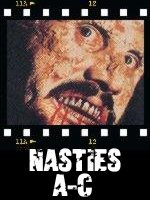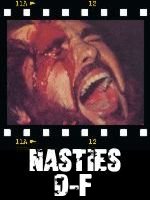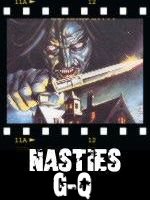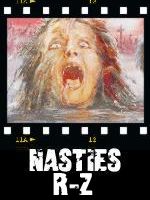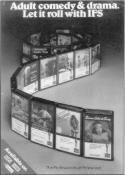 Home entertainment was quite different back in the early 80s.
There was no such thing as the Internet and there were only 3 (YES 3!!!) TV channels
in the UK (cable and satellite were still several years away).
Also, whereas today you can see your favourite shows repeated throughout the
week at different times, back then, shows were generally shown only once,
and at a set time. So if you missed your favourite programme, you'd have
to hope that it was repeated in 6 months time.
Home entertainment was quite different back in the early 80s.
There was no such thing as the Internet and there were only 3 (YES 3!!!) TV channels
in the UK (cable and satellite were still several years away).
Also, whereas today you can see your favourite shows repeated throughout the
week at different times, back then, shows were generally shown only once,
and at a set time. So if you missed your favourite programme, you'd have
to hope that it was repeated in 6 months time.
So when affordable video recorders became readily available in the early 80s, allowing people to watch, or even re-watch, their favourite programmes when they wanted, they were seen as something of a revolution and sales just went through the roof.
The other thing back then was if you wanted to see a film, you either had to go to the cinema, or wait till it came on TV (unless you were wealthy enough to own a Super 8mm projector). So with that in mind, a small group of enterprising distributors set about cashing in on the video boom by releasing pre-recorded films onto tape.
This idea proved hugely popular and the first dedicated video libraries opened up shortly afterwards. But the problem was, there wasn't a lot of choice to be had. The major studios were slow to adapt to this new medium, meaning shops were constantly struggling to find new titles to put on the shelves.
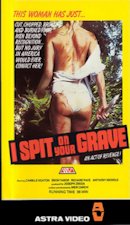 However,
unlike cinema, video lay outside the Cinematograph laws that
required either classification or government permission for it to be
distributed to the public. The technology was so new it had caught the authorities off
guard. So with this in mind, and in order to fill the public's
constant demand for a wider variety of movies on tape, the
distributors quickly began putting out a load of gory, foreign, low budget, horror
films, many of which would have never made it through the film censors.
And so the "Video Nasty" was born...
However,
unlike cinema, video lay outside the Cinematograph laws that
required either classification or government permission for it to be
distributed to the public. The technology was so new it had caught the authorities off
guard. So with this in mind, and in order to fill the public's
constant demand for a wider variety of movies on tape, the
distributors quickly began putting out a load of gory, foreign, low budget, horror
films, many of which would have never made it through the film censors.
And so the "Video Nasty" was born...
It's also worth bearing in mind that film censorship back then was fairly problematic in the UK. Whereas the average cinema goer today is free to revel in the gore and bloodshed of films like the "Saw" or "Hostel" franchises. In those days, the censors were fairly scissor happy, and movies were routinely cut, or even banned outright, by the British Board of Film Classifications (remember that "Dawn of the Dead" [1978] was only passed fully uncut in 2003 and "Texas Chainsaw Massacre" [1974] was banned outright in the UK right up until 1999).
So, if you were a horror fan, it was like a breath of fresh air being able to go down to your local rental library and pick up such wonderful titles as "I Spit on Your Grave", "Snuff" and "Zombie Flesh Eaters".
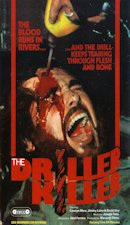 But
of course, there was no way the authorities were going to allow this
to continue, so it was only a matter of time before they decided to
take action. The problems started in 1982, when distributors Vipco
and Go Video were both censured by the Advertising Standards
Authority for taking out gory full page adverts for the films "The
Driller Killer", "Cannibal Holocaust" and "SS Experiment Camp" in
various video magazines.
But
of course, there was no way the authorities were going to allow this
to continue, so it was only a matter of time before they decided to
take action. The problems started in 1982, when distributors Vipco
and Go Video were both censured by the Advertising Standards
Authority for taking out gory full page adverts for the films "The
Driller Killer", "Cannibal Holocaust" and "SS Experiment Camp" in
various video magazines.
This caught the attention of the media and the ever vigilant gutter press, most notably The Sunday Times, Daily Mail and Daily Express, started running outrageous articles about the "evils" of home video, calling on morality groups, church leaders and the ever obnoxious Mary Whitehouse and her National Viewers and Listeners Assosiation (now called Mediwatch UK) to back up their ridiculous stories.
This was the catalyst that set the authorities wheels in motion and the police subsequently started raiding video shops and distributors up and down the country looking for material they felt was liable to be in breach of the Obscene Publications Act. An archaic piece of legislation that dates back to the 1800s, which prevents the distribution of materials liable to "deprave or corrupt" (whatever that means).
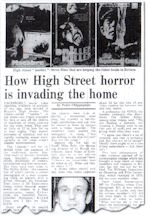 Of course, with different police
forces and different courts having widely differing opinions over
what is "obscene", this resulted in a lot of titles being seized
which perhaps shouldn't have been and a lot of police time and
effort wasted.
Of course, with different police
forces and different courts having widely differing opinions over
what is "obscene", this resulted in a lot of titles being seized
which perhaps shouldn't have been and a lot of police time and
effort wasted.
The Government's Department of Public Prosecutions subsequently drew up a list of these films they felt where likely to be judged obscene by the courts for the police to concentrate their efforts on. Of course, the DPP had no more idea about the content of these films than the police and many titles added to the list were simply done so on the basis of its lurid title, graphic box artwork or recommendations by the press. Meaning that many titles added to the original list were dropped soon after.
Whilst there were many films being branded as "nasties" by the media, not all of these made the list, which has lead to some confusion over the years as to what is and isn't a "true" nasty (the term is still bandied about today occaisionally by the media, to describe unsavoury horror films, which also creates confusion over its use)
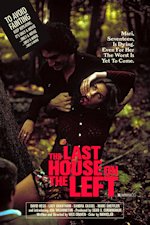 Altogether there where 72 different titles that appeared on the
list at one time or another (though some sources erroneously cite 74). The
original list contained 52 titles, but many more where added soon
after and others dropped, leaving a final total of just 39 which
were successfully prosecuted.
Altogether there where 72 different titles that appeared on the
list at one time or another (though some sources erroneously cite 74). The
original list contained 52 titles, but many more where added soon
after and others dropped, leaving a final total of just 39 which
were successfully prosecuted.
This "purge" by the DPP went on until the Government finally introduced the "Video recordings Act" in 1984, which was proposed by an idiot MP named Graham Bright, which outlawed the trade in unclassified tapes and required that all video films be submitted to the "British Board of Film Classifications" for vetting prior to release. This ended the availability of the more infamous titles, and the nasties furore by the media, and of course the need for any further prosecutions by the DPP.
But that wasn't quite the end of the story, there was a 12 month period of grace given to clear all
uncertified tapes out of the system, meaning some titles were still around for a while. But during this
period, the authorities brought out a
secondary list, containing 82 titles, which they
felt were likely to fall foul of Section 3 of the Obscene
Publications act. These lists were circulated round video shops with
orders that these titles be pulled from shelves, otherwise they were
liable to be seized and destroyed (these titles shall be covered
elsewhere) in an attempt to hasten the removal of any
semi-contentious films.

The result of this legisltion meant that it would now cost a substantial sum of money to release a film on video, owing to the exorbitant charges incurred by submitting the film to the BBFC. This shut down the majority of independant distributors pretty much overnight and with the overly censorious BBFC dictatiing what films were acceptable for home video use and major studios now starting to release their films on tape, the UK video market was never the same again.
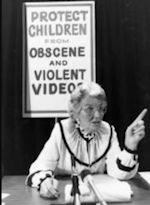 Of
course, we live in a somewhat more enlightened age now. The
BBFC rarely cut or ban anything, except where the content is liable
to break UK laws and many of these old so-called "Video Nasties" are
simply regarded as poorly made indie films and not worth banning, as
is evidenced by the fact that so many of them have since been passed
uncut.
Of
course, we live in a somewhat more enlightened age now. The
BBFC rarely cut or ban anything, except where the content is liable
to break UK laws and many of these old so-called "Video Nasties" are
simply regarded as poorly made indie films and not worth banning, as
is evidenced by the fact that so many of them have since been passed
uncut.
So with that, let us take a stroll down memory lane, back to those days in the early 80's when video was the latest thing, recap over all that media hysteria that changed the face of the UK video market and take a look at all those titles that earned a feel of the collar by the local constabulary.
The information on the following pages has been gathered from various sources, mostly from "Dark Side Magazine" , Dave Taylor's "Melon Farmers Video Hits" website, the "BBFC" website, the "Internet Movie Database", the book "See No Evil" by David Kerekes and David Slater and the documentary "Video Nasties : Moral Panic" by Nucleus films.

